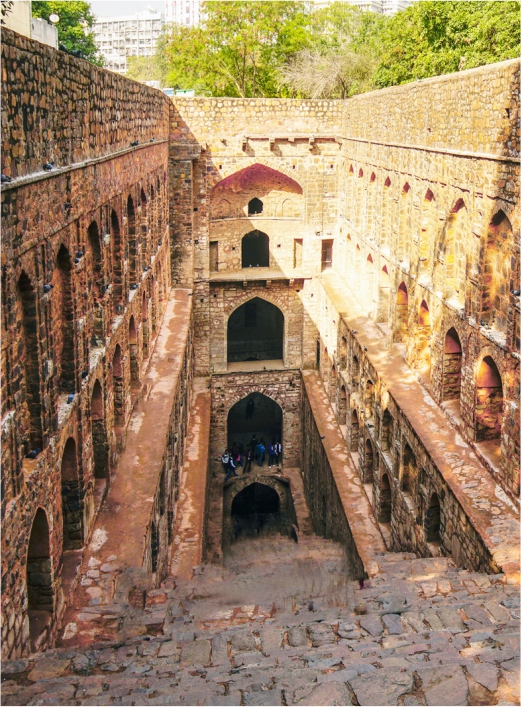Red Fort, New Delhi
Been there recently?
Shah Jahan, the fifth Mughal Emperor of India, had the Red Fort Complex built as the palace fort of his new capital city of Shahjahanabad. It is referred to as the pinnacle of Mughal creativity and is so named because of the enormous red sandstone walls that surround it. The palace’s layout is based on Islamic models, but each of its pavilions displays architectural features typical of Mughal structures, reflecting a synthesis of Persian, Timurid, and Hindu traditions. This UNESCO World Heritage Site, also known as qila-e-mubaraq, is one of the most stunning structures in the entire world. It is filled with palaces, pavilions, and mosques. The Red Fort is renowned for its enormous enclosing walls and was constructed by the Mughal emperor Shah Jahan as the palace fort of his capital, Shahjahanabad. The fort’s architecture is a seamless synthesis of Hindu, Islamic, Persian, and Timurid styles. The Diwan-i-khas, also known as the Shah Mahal, the Diwan-i-aam, also known as the Hall of Public Audience, and the Rang Mahal (a part of the harem), also known as Imtiyaz Mahal, are the main attractions. The Naubat Khana (Drum House), the hammam (royal bath), and the Muthamman Burj, also known as the Musamman Burj (a tower where the emperor would reveal himself to his subjects), are the additional monuments in this area. A trip to the old fort provides a timeless glimpse into Delhi’s bygone era.
Nearby Places to See
Gurudwara Bangla Sahib
Gurudwara Bangla Sahib, a peaceful haven amidst the bustling marketplace, is Connaught Place’s most well-known landmark. It can be seen from a distance thanks to the high golden dome that shimmers in the sunlight. You’ll feel at peace as soon as you step onto the property. You can take a stroll around the serene pond in the Gurudwara after paying respects at the sanctum, which houses the holy book. A kitchen area, a sizable art gallery, and a school are additional standout features. Devotees are provided with langar (holy food). According to legend, Raja Jai Singh, the ruler of Amber, once lived in Jaisinghpura Palace, which is where the Gurudwara area is now. The eighth Sikh guru, Guru Har Krishan Sahib, is said to have stayed in this palace in 1664.
Gurudwara Bangla Sahib, a peaceful haven amidst the bustling marketplace, is Connaught Place’s most well-known landmark. It can be seen from a distance thanks to the high golden dome that shimmers in the sunlight. You’ll feel at peace as soon as you step onto the property. You can take a stroll around the serene pond in the Gurudwara after paying respects at the sanctum, which houses the holy book. A kitchen area, a sizable art gallery, and a school are additional standout features. Devotees are provided with langar (holy food). According to legend, Raja Jai Singh, the ruler of Amber, once lived in Jaisinghpura Palace, which is where the Gurudwara area is now. The eighth Sikh guru, Guru Har Krishan Sahib, is said to have stayed in this palace in 1664.


Agrasen Baoli
Agrasen-ki-baoli, a charming and tranquil location amidst the commotion of Delhi, offers a glimpse into the past of the city’s capital. It is a historical step well that is 60 m long and 15 m wide. Its historical significance, intricate design, and serene atmosphere have made the monument popular with filmmakers as well. Films like Sultan and PK have used the monument as a backdrop. The cool air rushes in as you make your way down the deep stepwell. As the monument was once thought to be haunted, it might even give you the chills. It is now a protected monument, according to the Archaeological Survey of India (ASI). The identity of its builder is unknown, but it is thought that the legendary king Agrasen constructed it before the Agrawal community rebuilt it in the fourteenth century.
Agrasen-ki-baoli, a charming and tranquil location amidst the commotion of Delhi, offers a glimpse into the past of the city’s capital. It is a historical step well that is 60 m long and 15 m wide. Its historical significance, intricate design, and serene atmosphere have made the monument popular with filmmakers as well. Films like Sultan and PK have used the monument as a backdrop. The cool air rushes in as you make your way down the deep stepwell. As the monument was once thought to be haunted, it might even give you the chills. It is now a protected monument, according to the Archaeological Survey of India (ASI). The identity of its builder is unknown, but it is thought that the legendary king Agrasen constructed it before the Agrawal community rebuilt it in the fourteenth century.
Jama Masjid
One of the largest mosques in all of India is Jama Masjid, located in Old Delhi. The Mughal emperor Shah Jahan oversaw its completion, which had begun in 1644. This beautiful mosque, constructed of red sandstone and marble, is also known as Masjid-I-Jahanuma, which translates to “mosque commanding the view of the world.” The courtyard is large enough to comfortably accommodate 25,000 worshipers. Jama Masjid rises 10 metres above ground and features three gates, two 40-metre-tall minarets, and four towers. From the tower, visitors have a breathtaking panorama of the vibrant streets of Old Delhi below.
One of the largest mosques in all of India is Jama Masjid, located in Old Delhi. The Mughal emperor Shah Jahan oversaw its completion, which had begun in 1644. This beautiful mosque, constructed of red sandstone and marble, is also known as Masjid-I-Jahanuma, which translates to “mosque commanding the view of the world.” The courtyard is large enough to comfortably accommodate 25,000 worshipers. Jama Masjid rises 10 metres above ground and features three gates, two 40-metre-tall minarets, and four towers. From the tower, visitors have a breathtaking panorama of the vibrant streets of Old Delhi below.


Dilli Haat
Dilli Haat is a fusion of food, crafts, and cultural extravaganzas. This one-of-a-kind bazaar in the centre of the city showcases the diversity of Indian culture. The market offers a variety of traditional and ethnic goods for purchase. The haat also provides some delectable food items at reasonable prices. You can go to the various food stands established by the various Indian states, each of which serves regional specialties in their native authenticity. Experiencing the haat is a unique experience because it allows you to sample the rich cultural heritage of every state in India. Brassware, metal crafts, gems, beads, silk and wool fabrics, embellished footwear, and sandalwood and rosewood carvings are some of the items available for purchase.
Dilli Haat is a fusion of food, crafts, and cultural extravaganzas. This one-of-a-kind bazaar in the centre of the city showcases the diversity of Indian culture. The market offers a variety of traditional and ethnic goods for purchase. The haat also provides some delectable food items at reasonable prices. You can go to the various food stands established by the various Indian states, each of which serves regional specialties in their native authenticity. Experiencing the haat is a unique experience because it allows you to sample the rich cultural heritage of every state in India. Brassware, metal crafts, gems, beads, silk and wool fabrics, embellished footwear, and sandalwood and rosewood carvings are some of the items available for purchase.
India Gate
India Gate is one of Delhi’s most iconic structures, a magnificent arch built as a tribute to the valiant soldiers who gave their lives for the nation. This 42-metre-high gate, which was constructed of sandstone, was the first of its kind in the national capital. In addition to the 90,000 Indian Army soldiers who lost their lives in World War I, the walls of the gateway bear the names of 13,516 soldiers who died during the Afghan War of 1919 in the Northwestern Frontier. India Gate’s base is constructed from red Bharatpur stones, and its design is reminiscent of France’s Arc-de-Triomphe.
India Gate is one of Delhi’s most iconic structures, a magnificent arch built as a tribute to the valiant soldiers who gave their lives for the nation. This 42-metre-high gate, which was constructed of sandstone, was the first of its kind in the national capital. In addition to the 90,000 Indian Army soldiers who lost their lives in World War I, the walls of the gateway bear the names of 13,516 soldiers who died during the Afghan War of 1919 in the Northwestern Frontier. India Gate’s base is constructed from red Bharatpur stones, and its design is reminiscent of France’s Arc-de-Triomphe.


-
Destination



